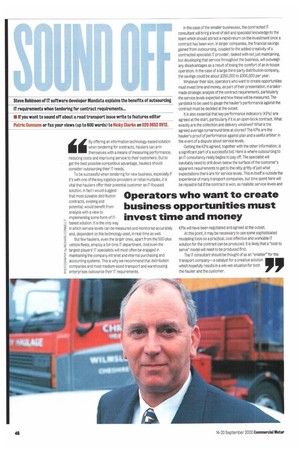By offering an information technology-based solution when tendering for contracts,
Page 48

If you've noticed an error in this article please click here to report it so we can fix it.
hauliers can arm themselves with a means of measuring performance, reducing costs and improving service to their customers. But to get the best possible competitive advantage, hauliers should consider outsourcing their IT needs.
To be successful when tendering for new business, especially if it's with one of the key logistics providers or retail multiples, it is vital that hauliers offer their potential customer an IT-focused solution. In fact I would suggest that most sizeable distribution contracts, existing and potential, would benefit from analysis with a view to implementing some form of IT L.' based solution. It is the only way in which service levels can be measured and monitored accurately 0 (-) and, dependent on the technology used, in real-time as well.
But few hauliers, even the larger ones, apart from the 500-plus cc--2 vehicle fleets, employ a full-time IT department. And even the 2'. largest players' IT specialists will most often be engaged in
maintaining the company intranet and internal purchasing and es accounting systems. This is why we recommend that distribution
!'-pcompanies and most medium-sized transport and warehousing 0
EL enterprises outsource their FT requirements. In the case of the smaller businesses, the contracted IT consultant will bring a level of skill and specialist knowledge to the team which should attract a rapid return on the investment once a contract has been won. In larger companies, the financial savings gained from outsourcing, coupled to the added creativity of a contracted specialist IT provider, tasked with not just maintaining, but developing that service throughout the business, will outweigh any disadvantages as a result of losing the comfort of an in-house operation. in the case of a large third-party distribution company, the savings could be about 2250,000 to 2300,000 per year.
Whatever their size, operators who want to create opportunities must invest time and money, as part of their presentation, in a tailormade strategic analysis of the contract requirements, particularly the service levels expected and how these will be measured. The yardstick to be used to gauge the haulier's performance against the contract must be decided at the outset.
It is also essential that key performance indicators (KPIs) are agreed at the start, particularly if it is an open-book contract. What exactly are the collection and delivery windowsP What is the agreed average turnaround time at stores P The KPIs are the haulier's proof of performance against plan and a useful arbiter in the event of a dispute about service levels.
Getting the KPIs agreed, together with the other information, is a significant part of a successful bid. Here is where outsourcing to an IT consultancy really begins to payoff-The specialist will inevitably need to drill down below the surface of the customer's apparent requirements to get to the nitty-gritty of just what expectations there are for service levels. This in itself is outside the experience of many transport companies, but time spent here will be repaid in full if the contract is won, as realistic service levels and KPIs will have been negotiated and agreed at the outset.
At this point, it may be necessary to use some sophisticated modelling tools so a practical, cost effective and workable IT solution for the contract can be produced. it is likely that a "cost to serve" model will need to be produced first, The IT consultant should be thought of as an "enabler' for the transport company—a catalyst for a creative solution which hopefully results in a win-win situation for both the haulier and the customer.








































































































